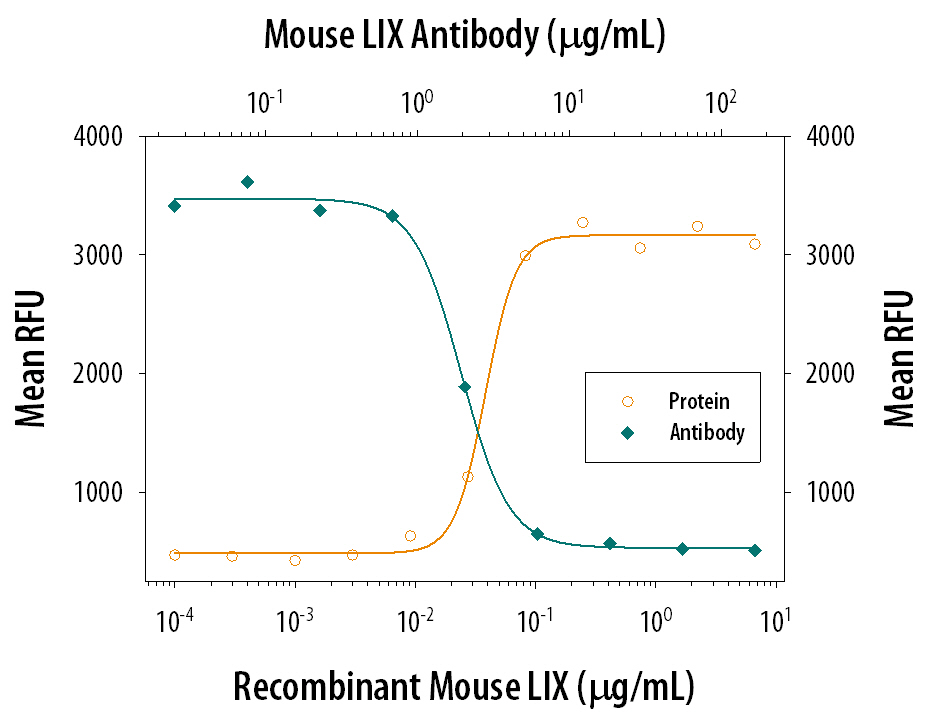Mouse LIX Antibody Summary
Applications
Mouse LIX Sandwich Immunoassay
Please Note: Optimal dilutions should be determined by each laboratory for each application. General Protocols are available in the Technical Information section on our website.
Scientific Data
 View Larger
View Larger
Chemotaxis Induced by LIX and Neutralization by Mouse LIX Antibody. Recombinant Mouse LIX (Catalog # 433-MC) chemoattracts the BaF3 mouse pro-B cell line transfected with human CXCR2 in a dose-dependent manner (orange line). The amount of cells that migrated through to the lower chemotaxis chamber was measured by Resazurin (Catalog # AR002). Chemotaxis elicited by Recombinant Mouse LIX (0.2 µg/mL) is neutralized (green line) by increasing concen-trations of Rat Anti-Mouse LIX Monoclonal Antibody (Catalog # MAB433). The ND50 is typically 0.5-2.5 µg/mL.
Reconstitution Calculator
Preparation and Storage
- 12 months from date of receipt, -20 to -70 degreesC as supplied. 1 month, 2 to 8 degreesC under sterile conditions after reconstitution. 6 months, -20 to -70 degreesC under sterile conditions after reconstitution.
Background: LIX
LIX (Liposaccharide-Induced CXC chemokine; also GARG-8) is a secreted 8-9 kDa member of the Intercrine alpha (or CxC) family of chemokines. It is widely expressed, being produced by diverse cell types such as fibroblasts, thymic epithelium, platelets, vascular endothelium, hepatocytes, lung type II alveolar cells and ileal columnar epithelium. As a chemokine, LIX demonstrates chemokinetic properties. It induces the chemotaxis of neutrophils and endothelial cells, and also promotes TNF-alpha secretion from mast cells and macrophages. Notably, circulating LIX is not derived from fibroblasts, but platelets. This suggests that neutrophil homeostasis/chemotaxis is a function of local resident cell activation and LIX secretion, not generally circulating LIX. Mouse LIX is synthesized as a 132 amino acid (aa) precursor that contains a 40 aa signal sequence, a 78 aa mature region (aa 41-118), and a cleavable 14 aa C-terminus. The mature region possesses an ELR/GluLeuArg motif between aa 50-52, and an alpha -family characteristic CxC motif between aa 53-55. Although there are no known splice variants of mouse LIX, considerable proteolytic processing occurs at both the N- and C-termini over aa 41-132. This may reduce the MW in SDS-PAGE by as much as 3 kDa. The majority of LIX appears to start between aa 47-50, and this is positively correlated with bioactivity. Over aa 41-118, mouse LIX shares 73% aa sequence identity with rat LIX. Although not a strict ortholog, mouse LIX shares 63% aa sequence identity with human GCP-2.
Product Datasheets
Citations for Mouse LIX Antibody
R&D Systems personnel manually curate a database that contains references using R&D Systems products. The data collected includes not only links to publications in PubMed, but also provides information about sample types, species, and experimental conditions.
11
Citations: Showing 1 - 10
Filter your results:
Filter by:
-
CXCR1 drives the pathogenesis of EAE and ARDS via boosting dendritic cells-dependent inflammation
Authors: Zhuang, W;Zhou, J;Zhong, L;Lv, J;Zhong, X;Liu, G;Xie, L;Wang, C;Saimaier, K;Han, S;Shi, C;Hua, Q;Zhang, R;Xie, X;Du, C;
Cell death & disease
Species: Mouse
Sample Types: In Vivo
Applications: In vivo assay -
IL-17/CXCL5 signaling within the oligovascular niche mediates human and mouse white matter injury
Authors: G Xiao, R Kumar, Y Komuro, J Burguet, V Kakarla, I Azizkhania, SA Sheth, CK Williams, XR Zhang, M Macknicki, A Brumm, R Kawaguchi, P Mai, N Kaneko, HV Vinters, ST Carmichael, LA Havton, C DeCarli, JD Hinman
Cell Reports, 2022-12-20;41(12):111848.
Species: Mouse
Sample Types: Whole Tissue
Applications: IHC -
Early growth response 1 deficiency protects host against Pseudomonas aeruginosa lung infection
Authors: Z Pang, R Raudonis, C McCormick, Z Cheng
Infect. Immun., 2019-12-17;0(0):.
Species: Mouse
Sample Types: BALF
Applications: ELISA Capture -
The CXCL5/CXCR2 axis is sufficient to promote breast cancer colonization during bone metastasis
Authors: R Romero-Mor, KJ Curtis, TR Coughlin, M Cristina M, S Dutta, A Natarajan, BA Facchine, KM Jackson, L Nystrom, J Li, W Kaliney, GL Niebur, LE Littlepage
Nat Commun, 2019-09-27;10(1):4404.
Species: Mouse
Sample Types: Whole Tissue
Applications: IHC-P -
Pulmonary Epithelial TLR4 Activation Leads to Lung Injury in Neonatal Necrotizing Enterocolitis
Authors: Hongpeng Jia
J Immunol, 2016-06-15;0(0):.
Species: Mouse
Sample Types: In Vivo
Applications: Neutralization -
Regulator of calcineurin 1 suppresses inflammation during respiratory tract infections.
Authors: Junkins R, MacNeil A, Wu Z, McCormick C, Lin T
J Immunol, 2013-04-15;190(10):5178-86.
Species: Mouse
Sample Types: BALF
Applications: ELISA Development (Capture) -
In vivo processing of CXCL5 (LIX) by matrix metalloproteinase (MMP)-2 and MMP-9 promotes early neutrophil recruitment in IL-1beta-induced peritonitis.
Authors: Song J, Wu C, Zhang X, Sorokin L
J Immunol, 2012-12-07;190(1):401-10.
Species: Mouse
Sample Types: Whole Tissue
Applications: IHC-Fr -
Castration-induced changes in mouse epididymal white adipose tissue.
Authors: Floryk D, Kurosaka S, Tanimoto R, Yang G, Goltsov A, Park S, Thompson TC
Mol. Cell. Endocrinol., 2011-07-12;345(1):58-67.
Species: Mouse
Sample Types: Whole Tissue
Applications: IHC-P -
Matrix metalloproteinase-8 deficiency promotes granulocytic allergen-induced airway inflammation.
Authors: Gueders MM, Balbin M, Rocks N, Foidart JM, Gosset P, Louis R, Shapiro S, Lopez-Otin C, Noel A, Cataldo DD
J. Immunol., 2005-08-15;175(4):2589-97.
Species: Mouse
Sample Types: Tissue Homogenates
Applications: Western Blot -
Transcriptional profiling of lipopolysaccharide-induced acute lung injury.
Authors: Jeyaseelan S, Chu HW, Young SK, Worthen GS
Infect. Immun., 2004-12-01;72(12):7247-56.
Species: Mouse
Sample Types: Tissue Homogenates, Whole Cells
Applications: ELISA Development, Neutralization -
Circulating CXC-chemokine concentrations in a murine intestinal ischemia-reperfusion model.
Authors: Maheshwari A, Christensen RD, Calhoun DA
Fetal Pediatr Pathol, 2004-03-01;23(2):145-57.
Species: Mouse
Sample Types: Serum
Applications: ELISA Development
FAQs
No product specific FAQs exist for this product, however you may
View all Antibody FAQsReviews for Mouse LIX Antibody
There are currently no reviews for this product. Be the first to review Mouse LIX Antibody and earn rewards!
Have you used Mouse LIX Antibody?
Submit a review and receive an Amazon gift card.
$25/€18/£15/$25CAN/¥75 Yuan/¥2500 Yen for a review with an image
$10/€7/£6/$10 CAD/¥70 Yuan/¥1110 Yen for a review without an image

